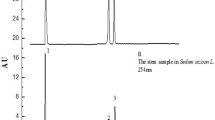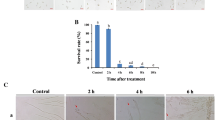Abstract
Fusarium oxysporum f. sp. radicis-lycopersici (Forl) causes Fusarium crown and root rot of tomato, leading to severe yield losses. Chinese chive and the Chinese chive extract reportedly have antifungal effects. In this study, Chinese chive extract treatments inhibited Forl spore germination, with an EC50 of 0.40 g ml−1 in vitro. Furthermore, the mechanism underlying the fungicidal effects of the Chinese chive extract was analyzed by RNA sequencing. A total of 1252 differentially expressed genes (DEGs) were detected, of which 396 were upregulated and 856 were downregulated. The DEGs were related to starch and sucrose metabolism, amino sugar and nucleotide sugar metabolism, galactose metabolism, fatty acid metabolism, sphingolipid metabolism, glycerophospholipid metabolism, peroxisomes, ribosome biogenesis in eukaryotes, mismatch repair, and the phosphatidylinositol signaling system, implying these pathways contribute to the fungicidal activity of the Chinese chive extract. The qRT-PCR results verified the accuracy of the RNA sequencing data. Thus, the Chinese chive extract can inhibit Forl spore germination by affecting spore nutrient metabolism.





Similar content being viewed by others
References
Lagopodi AL, Ram AF, Lamers GE, Punt PJ, Ca VDH, Lugtenberg BJ, Bloemberg GV (2002) Novel aspects of tomato root colonization and infection by Fusarium oxysporum f. sp. radicis-lycopersici revealed by confocal laser scanning microscopic analysis using the green fluorescent protein as a marker. Mol Plant Microbe Interact 15(2):172–179. https://doi.org/10.1094/MPMI.2002.15.2.172
De Ascensao ARDCF, Dubery IA (2000) Panama disease: cell wall reinforcement in banana roots in response to elicitors from Fusarium oxysporum f. sp. cubense race four. Phytopathology 90(10):1173–1180. https://doi.org/10.1094/PHYTO.2000.90.10.1173
Dowd C, Wilson IW, Mcfadden H (2004) Gene expression profile changes in cotton root and hypocotyl tissues in response to infection with Fusarium oxysporum f. sp. vasinfectum. Mol Plant Microbe Interact 17(6):654–667. https://doi.org/10.1094/MPMI.2004.17.6.654
Horinouchi H, Katsuyama N, Taguchi Y, Hyakumachi M (2008) Control of Fusarium crown and root rot of tomato in a soil system by combination of a plant growth-promoting fungus, Fusarium equiseti, and biodegradable pots. Crop Prot 27(3):859–864. https://doi.org/10.1016/j.cropro.2007.08.009
Mcgovern RJ (2015) Management of tomato diseases caused by Fusarium oxysporum. Crop Prot 73:78–92. https://doi.org/10.1016/j.cropro.2015.02.021
Can C, Yucel S, Korolev N, Katan T (2010) First report of Fusarium crown and root rot of tomato caused by Fusarium oxysporum f. sp. radicis-lycopersici in Turkey. Plant Pathol 53(6):814–814. https://doi.org/10.1111/j.1365-3059.2004.01087.x
Castano R, Borrero C, Trillas MI, Avilés M (2013) Selection of biological control agents against tomato Fusarium wilt and evaluation in greenhouse conditions of two selected agents in three growing media. BioControl 58(1):105–116. https://doi.org/10.1007/s10526-012-9465-z
Omar I, O’Neill TM, Rossall S (2006) Biological control of Fusarium crown and root rot of tomato with antagonistic bacteria and integrated control when combined with the fungicide carbendazim. Plant Pathol 55(1):92–99. https://doi.org/10.1111/j.1365-3059.2005.01315.x
Mazzeo MF, Cacace G, Ferriello F, Puopolo G, Zoina A, Ercolano MR, Siciliano RA (2014) Proteomic investigation of response to FORL infection in tomato roots. Plant Physiol Biochem 74:42–49. https://doi.org/10.1016/j.plaphy.2013.10.031
Benhamou N, Bélanger RR (1998) Benzothiadiazole-mediated induced resistance to Fusarium oxysporum f. sp. radicis-lycopersici in tomato. Plant Physiol 118(4):1203–1212. https://doi.org/10.2307/4278551
Myresiotis CK, Karaoglanidis GS, Zisis V, Euphemia PM (2012) Evaluation of plant-growth-promoting rhizobacteria, acibenzolar-S-methyl and hymexazol for integrated control of Fusarium crown and root rot on tomato. Pest Manag Sci 68(3):404–411. https://doi.org/10.1002/ps.2277
Grahovac M, Inđić D, Lazić S, Vuković S (2009) Biofungicides and their applicability in modern agricultural practice. Pesticidi I Fitomedicina 24(4):245–258. https://doi.org/10.2298/PIF0904245G
Elwakeil NE (2013) Botanical pesticides and their mode of action. Gesunde Pflanzen 65(4):125–149. https://doi.org/10.1007/s10343-013-0308-3
Du R, Liu J, Sun P, Li H, Wang J (2017) Inhibitory effect and mechanism of Tagetes erecta L. fungicide on Fusarium oxysporum f. sp. niveum. Sci Rep 7(1):14442. https://doi.org/10.1038/s41598-017-14937-1
Sharma A, Rajendran S, Srivastava A, Sharma S, Kundu B (2017) Antifungal activities of selected essential oils against Fusarium oxysporum f. sp. lycopersici 1322, with emphasis on Syzygium aromaticum essential oil. J Biosci Bioeng 123(3):308–313. https://doi.org/10.1016/j.jbiosc.2016.09.011
Rattanachaikunsopon P, Phumkhachorn P (2008) Diallyl sulfide content and antimicrobial activity against food-borne pathogenic bacteria of chives (Allium schoenoprasum). J Agric Chem Soc Jpn 72(11):2987–2991. https://doi.org/10.1271/bbb.80482
Hui Z, Azim M, Sen ZR (2013) Control of Panama disease of banana by rotating and intercropping with Chinese chive (Allium tuberosum Rottler): role of plant volatiles. J Chem Ecol 39(2):243–252. https://doi.org/10.1007/s10886-013-0243-x
Mau J, Chen C, Hsieh P (2001) Antimicrobial effect of extracts from Chinese chive, cinnamon, and corni fructus. J Agric Food Chem 49(1):183. https://doi.org/10.1021/jf000263c
Rattanachaikunsopon P, Phumkhachorn P (2009) Potential of Chinese chive oil as a natural antimicrobial for controlling Flavobacterium columnare infection in Nile tilapia Oreochromis niloticus. Fish Sci 75(6):1431–1437. https://doi.org/10.1007/s12562-009-0171-4
Seo KI, Moon YH, Sang UC, Park KH (2001) Antibacterial activity of S-methyl methanethiosulfinate and S-methyl 2-propene-1-thiosulfinate from Chinese chive toward Escherichia coli O157:H7. J Agri Chem Soc Jpn 65(4):966–968. https://doi.org/10.1271/bbb.65.966
Zheng X, Zhang X, Zhao L, Apaliya MT, Yang Q, Sun W, Zhang X, Zhang H (2017) Screening of deoxynivalenol producing strains and elucidation of possible toxigenic molecular mechanism. Toxins 9(6):184. https://doi.org/10.3390/toxins9060184
Zhang M, Ge J, Yu X (2018) Transcriptome analysis reveals the mechanism of fungicidal of thymol against Fusarium oxysporum f. sp. niveum. Curr Microbiol 75(4):410–419. https://doi.org/10.1007/s00284-017-1396-6
Young MD, Wakefield MJ, Smyth GK, Oshlack A (2010) Gene ontology analysis for RNA-seq: accounting for selection bias. Genome Biol 11(2):R14. https://doi.org/10.1186/gb-2010-11-2-r14
Mao X, Tao CJGO, Wei L (2005) Automated genome annotation and pathway identification using the KEGG Orthology (KO) as a controlled vocabulary. Bioinformatics 21(19):3787–3793. https://doi.org/10.1093/bioinformatics/bti430
Guo L, Han L, Yang L, Zeng H, Fan D, Zhu Y, Feng Y, Wang G, Peng C, Jiang X (2015) Genome and transcriptome analysis of the fungal pathogen Fusarium oxysporum f. sp. cubense causing banana vascular wilt disease. PLoS ONE 10(1):e0117621. https://doi.org/10.1371/journal.pone.0117621
Chen W, Wei L, Zhang Y, Shi D, Ren W, Zhang Z, Wang J, Shao W, Liu X, Chen C (2018) Involvement of the two l-lactate dehydrogenase in development and pathogenicity in Fusarium graminearum. Curr Genet 65(4):591–605. https://doi.org/10.1007/s00294-018-0909-6
Sharma M, Sengupta A, Ghosh R, Agarwal G, Tarafdar A, Nagavardhini A, Pande S, Varshney RK (2016) Genome wide transcriptome profiling of Fusarium oxysporum f. sp. ciceris conidial germination reveals new insights into infection-related genes. Sci Rep 6:37353. https://doi.org/10.1038/srep37353
Klei IJVD, Veenhuis M (2013) The versatility of peroxisome function in filamentous fungi. Subcell Biochem 69:135–152. https://doi.org/10.1007/978-94-007-6889-5_8
Emma T, Sebastien FC, Ed H (2013) Eukaryotic ribosome biogenesis at a glance. J Cell Sci 126(21):4815–4821. https://doi.org/10.1242/jcs.111948
Deng GM, Yang QS, He WD et al (2015) Proteomic analysis of conidia germination in Fusarium oxysporum f. sp. cubense tropical race 4 reveals new targets in ergosterol biosynthesis pathway for controlling Fusarium wilt of banana. Appl Microbiol Biotechnol 99(17):7189–7207. https://doi.org/10.1007/s00253-015-6768-x
Segal LM, Wilson RA (2018) Reactive oxygen species metabolism and plant-fungal interactions. Fungal Genet Biol 110:1–9. https://doi.org/10.1016/j.fgb.2017.12.003
Kohanski MA, Dwyer DJ, Hayete B, Lawrence CA, Collins JJ (2007) A common mechanism of cellular death induced by bactericidal antibiotics. Cell 130(5):797–810. https://doi.org/10.1016/j.cell.2007.06.049
Shen Q, Zhou W, Li H, Hu L, Mo H (2016) ROS involves the fungicidal actions of thymol against spores of Aspergillus flavus via the induction of nitric oxide. PLoS ONE 11(5):e0155647. https://doi.org/10.1371/journal.pone.0155647
Gao T, Zhou H, Zhou W, Hu L, Chen J, Shi Z (2016) The fungicidal activity of Thymol against Fusarium graminearum via inducing lipid peroxidation and disrupting ergosterol biosynthesis. Molecules 21(6):770. https://doi.org/10.3390/molecules21060770
Jacob P, Stephen D (2005) The bacterial ribosome as a target for antibiotics. Nat Rev Microbiol 3(11):870–881. https://doi.org/10.1038/nrmicro1265
Chopra I, Roberts M (2001) Tetracycline antibiotics: mode of action, applications, molecular biology, and epidemiology of bacterial resistance. Microbiol Mol Biol Rev 65(2):232–260. https://doi.org/10.1016/S0022-3093(98)00783-2
Tenson T, Lovmar M, Ehrenberg M (2003) The mechanism of action of macrolides, lincosamides and streptogramin B reveals the nascent peptide exit path in the ribosome. J Mol Biol 330(5):1005–1014. https://doi.org/10.1016/s0022-2836(03)00662-4
Swagata N, Kmn P, Ananya B, Rohitas D, Vishal T (2013) PfRIO-2 kinase is a potential therapeutic target of antimalarial protein kinase inhibitors. Curr Drug Discov Technol 10(1):85–91. https://doi.org/10.2174/157016313804998933
Acknowledgements
We thank Liwen Bianji, Edanz Editing China (www.liwenbianji.cn/ac) for editing the English text of a draft of this manuscript.
Funding
This work was supported by Shandong Province Natural Science Foundation, China [ZR2014CQ034], Shandong Province Agricultural Fine Variety Project, China [2017LZGC013], Shandong Province Modern Agricultural Industry Technology System, Vegetable Industry Innovation Team, China [SDAIT-05-02], and Qingdao Livelihood Science and Technology Plan, China [18-6-1-114-nsh and 19-6-1-60-nsh]. This research work was carried out in Qingdao Key Laboratory of Genetic Improvement and Breeding of Horticultural Plants, China.
Author information
Authors and Affiliations
Contributions
FW was involved in the conception and design of the study, data analysis, draft and critical revision of article, and final approval; XZ and HW were involved in data acquisition, data analysis, draft and critical revision of article, and final approval, and contributed equally; WYZ and WLL were involved in data analysis, draft and critical revision of article, and final approval.
Corresponding author
Ethics declarations
Conflict of interest
The authors declare no potential conflict of interests.
Additional information
Publisher's Note
Springer Nature remains neutral with regard to jurisdictional claims in published maps and institutional affiliations.
Electronic supplementary material
Below is the link to the electronic supplementary material.
Rights and permissions
About this article
Cite this article
Zhang, X., Wang, H., Zhu, W. et al. Transcriptome Analysis Reveals the Effects of Chinese Chive (Allium tuberosum R.) Extract on Fusarium oxysporum f. sp. radicis-lycopersici Spore Germination. Curr Microbiol 77, 855–864 (2020). https://doi.org/10.1007/s00284-020-01875-x
Received:
Accepted:
Published:
Issue Date:
DOI: https://doi.org/10.1007/s00284-020-01875-x




